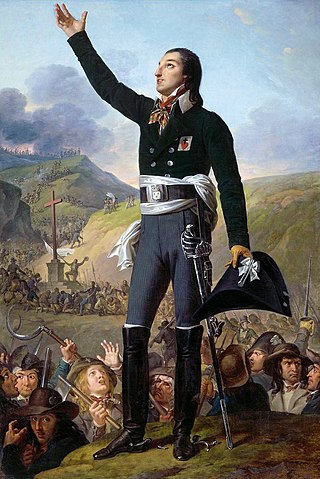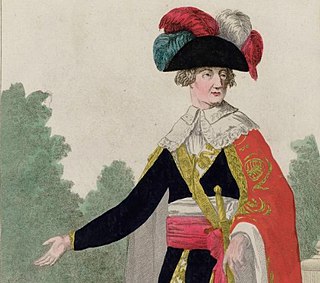
François Séverin Marceau-Desgraviers was a French general of the Revolutionary Wars.

Charles-Melchior Artus de Bonchamps, Marquis de Bonchamps was a French politician and leader of the Vendéan insurrection of Royalists against the Republic during the French Revolution.

Generalissimo Jacques Cathelineau was a French Vendéan insurrectionist leader during the Revolution. He was known among his followers as the Saint of Anjou.

The War in the Vendée was a counter-revolution from 1793 to 1796 in the Vendée region of France during the French Revolution. The Vendée is a coastal region, located immediately south of the river Loire in western France. Initially, the revolt was similar to the 14th-century Jacquerie peasant uprising, but the Vendée quickly became counter-revolutionary and Royalist. The revolt headed by the newly formed Catholic and Royal Army was comparable to the Chouannerie, which took place in the area north of the Loire.

François Athanase de Charette de la Contrie was a French military officer and politician. He served in the French Navy during the American Revolutionary War and was one of the leaders of the War in the Vendée against the French Revolutionary Army. His great-nephew Athanase-Charles-Marie Charette de la Contrie was a noted military leader and great-grandson of Charles X of France.

Louis Marie de Salgues, marquis de Lescure was a French soldier and opponent of the French Revolution, the cousin of Henri de la Rochejaquelein.

The Chouannerie was a royalist uprising or counter-revolution in twelve of the western départements of France, particularly in the provinces of Brittany and Maine, against the First Republic during the French Revolution. It played out in three phases and lasted from spring 1794 to 1800. The revolt was comparable to the War in the Vendée, which took place in the Vendée region.

Jean-François-Auguste Moulin1 was a general of the French Revolution and member of the French Directory. He had a long career as a military officer serving France in the Royal Army of King Louis XVI, the Garde Nationale of the French Revolution, and the Grande Armée of Napoleon Bonaparte.

The Battle of Entrames was fought on 27 October 1793 during the French Revolutionary Wars. It pitted Republican forces against Vendée Royalists near Entrames in Mayenne, and it resulted in a Royalist victory.
Pierre Quétineau was a general officer in the Army of the Coasts of La Rochelle during the War in the Vendée.

The Battle of Thouars was a battle between Royalist and Republican French forces during the War in the Vendée. The Royalists or Vendeans led by Louis Marie de Lescure, Charles de Bonchamps, and Henri de La Rochejaquelein seized the town of Thouars and compelled its Republican defenders under Pierre Quétineau to surrender.

The Battle of Nantes took place between Royalist and Republican French forces at Nantes on 29 June 1793 during the War in the Vendée. It consisted of the siege of that town, and was a Republican victory. Louis Marie Turreau wrote of it:
The siege of Nantes is perhaps the most important military event of our revolution. Perhaps the destinies of the Republic [herself] were tied to the resistance of this town.

The Battle of Savenay took place on 23 December 1793, and marks the end of the Virée de Galerne operational phase of the first war in the Vendée after the French Revolution. A Republican force of approximately 18,000 decisively defeated the Armée Catholique et Royale force of 6,000 at Savenay.
The Army of the West was one of the French Revolutionary Armies that was sent to fight in the War in the Vendée in western France. The army was created on 2 October 1793 by merging the Army of the Coasts of La Rochelle, the so-called Army of Mayence and part of the Army of the Coasts of Brest. In 1793 the army or its component forces fought at Second Châtillon, First Noirmoutier, La Tremblaye, Cholet, Laval, Entrames, Fougères, Granville, Dol, Angers, Le Mans and Savenay. After the main Vendean army was crushed, the revolt evolved into guerrilla warfare and there were few pitched battles. In 1794 Louis Marie Turreau tried to suppress the rebellion with extremely brutal methods using the infamous infernal columns. Calmer heads finally prevailed and Turreau was recalled. On 6 January 1796, the army was absorbed into the newly formed Army of the Coasts of the Ocean. The Army of the West came into existence a second time on 17 January 1800 and was finally suppressed on 21 May 1802.
Jean Léchelle or Jean L'Échelle briefly commanded a French army during the French Revolutionary Wars. Having served in the French Royal Army as a youth, the outbreak of the French Revolution found him employed as a fencing master. He was elected to lead a volunteer National Guard battalion which fought at Valmy and Jemappes in 1792. He earned promotion to general officer after distinguishing himself at the Siege of Valenciennes and saving a representative from an angry mob. He won such favor with the politicians and the war office that he was rapidly catapulted into command of an army in the War in the Vendée. After the capable battalion leader demonstrated his total unfitness for the post of army commander, he was just as quickly arrested and thrown into prison where he died, a probable suicide.
The Army of the Coasts of La Rochelle was an army of the French Revolution which was created on 30 April 1793 and responsible for defending a region from the mouth of the Loire River south to the Gironde. Despite its relatively short existence, the army fought numerous battles during the War in the Vendée including Thouars, Fontenay-le-Comte, Saumur, First Châtillon, Vihiers, Luçon, Chantonnay, Coron and Saint-Fulgent. Many of the battles resulted in Republican defeats at the hands of the Vendean Royalists. Of the two principal army commanders, Armand Louis de Gontaut, Duke of Biron was dismissed and later executed by guillotine while Jean Antoine Rossignol was a political appointee who was generally acknowledged to be incompetent. The army was absorbed by the Army of the West on 5 October 1793.

Antoine Philippe de La Trémoïlle, Prince of Talmont was a French noble and royalist notable for his military involvement against the French Revolution.
Charles Aimé de Royrand became a Vendean leader in the War in the Vendée, a revolt against the French Revolution. He joined the French Royal Army and served in an infantry regiment during the American Revolutionary War before retiring to his estates in 1780. When the Vendean insurrection broke out in 1793 he was chosen as the leader of the southern army. He led rebel forces at Luçon, Cholet and Entrames. He was fatally wounded at Entrames on 26 October and died at Baugé-en-Anjou.
The Battle of Coron was fought between Royalist and Republican French forces near Coron during the War in the Vendée. A Republican division from Saumur led by Antoine Joseph Santerre beat Royalist Vendeans at Doué-la-Fontaine on 15 September and at Vihiers on the 17th. However, on 18 September Santerre's division blundered into an ambush between Vihiers and Coron set by Louis Marie de Lescure and Dominique Piron. The Republican column was routed and lost all its artillery. A few days later, a flanking Republican division under Charles François Duhoux was beaten in the Battle of Pont-Barré. In mid-September the Republican Army of the Coasts of La Rochelle under Jean Antoine Rossignol advanced into the Vendée from the south and east at the same time as the Army of the Coasts of Brest and the Army of Mainz commanded by Jean Baptiste Camille Canclaux marched in from the west. In battles at Coron, Pont-Barré, Tiffauges, Montaigu and Saint-Fulgent, the Vendean rebels massed against and defeated each Republican invading column.

The Battle of Pont-Barré saw Royalist Vendeans under Pierre Duhoux and Dominique Piron de La Varenne fighting a Republican French column under Charles François Duhoux near Saint-Lambert-du-Lattay. Duhoux's Republican column advanced southwest from Angers and encountered Vendean defenders led by his nephew Pierre at the bridge over the Layon River. The rebels held their ground until reinforcements under Piron La Varenne arrived and gained the upper hand. The Vendeans put the Republicans to flight, killing 1,362 soldiers and capturing all their artillery. The action was part of a Republican strategy of invading the Vendée from several different directions. The rebels concentrated against and defeated the encroaching columns one by one at Coron, Tiffauges, Pont-Barré, Montaigu and Saint-Fulgent.














